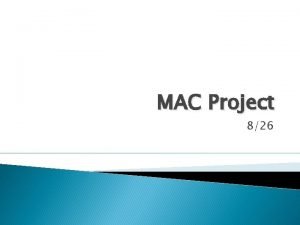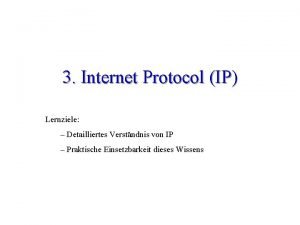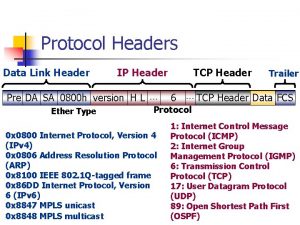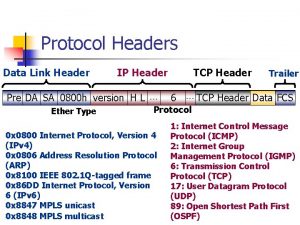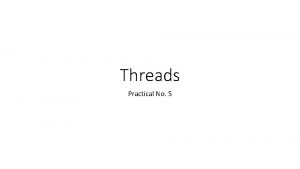Proposal for IEEE 802 16 m Superframe Header












- Slides: 12

Proposal for IEEE 802. 16 m Super-frame Header Design IEEE 802. 16 Presentation Submission Template (Rev. 9) Document Number: IEEE S 802. 16 m-08/489 Date Submitted: 2008 -05 -05 Source: Sassan Ahmadi (sassan. ahmadi@intel. com) Shantidev Mohanty (shantidev. mohanty@intel. com) Intel Corporation *<http: //standards. ieee. org/faqs/affiliation. FAQ. html> Venue: (Macau, China, May 2008) Base Contribution: IEEE 802. 16 m-08/489 Purpose: Discussion Notice: This document does not represent the agreed views of the IEEE 802. 16 Working Group or any of its subgroups. It represents only the views of the participants listed in the “Source(s)” field above. It is offered as a basis for discussion. It is not binding on the contributor(s), who reserve(s) the right to add, amend or withdraw material contained herein. Release: The contributor grants a free, irrevocable license to the IEEE to incorporate material contained in this contribution, and any modifications thereof, in the creation of an IEEE Standards publication; to copyright in the IEEE’s name any IEEE Standards publication even though it may include portions of this contribution; and at the IEEE’s sole discretion to permit others to reproduce in whole or in part the resulting IEEE Standards publication. The contributor also acknowledges and accepts that this contribution may be made public by IEEE 802. 16. Patent Policy: The contributor is familiar with the IEEE-SA Patent Policy and Procedures: <http: //standards. ieee. org/guides/bylaws/sect 6 -7. html#6> and <http: //standards. ieee. org/guides/opman/sect 6. html#6. 3>. Further information is located at <http: //standards. ieee. org/board/pat-material. html> and <http: //standards. ieee. org/board/pat >. 1

Outline • IEEE 802. 16 m frame structure • Downlink control information in 16 m frame structure • System parameters and system configuration information • Super-frame header design • Summary 2

802. 16 m Super-Frame Concept FDD and TDD Modes Super-Frame Header: System Configuration Information, Paging, other Broadcast Information Frame (Frames are numbered F#0 to F#3) Sub-Frame (Sub-frames are numbered SF#0 to SF#7) OFDM Symbols (Symbols are numbered S#0 to S#5) 3

Timing References and Frame Contents Legacy Preamble Legacy Control New Channels Preamble Super-Frame Common Control Header and Signaling Channel System Bandwidth Minimum Bandwidth Legacy Frame 5 ms Timing Reference for Beginning of the New Frame 5 ms Frame Offset Timing Reference for Beginning of the Legacy Frame Super-Frame 20 ms Frequency 4 Time

DL Broadcast Control Message Structure Legacy Preamble Legacy Control New Channels Preamble Legacy Frame 5 ms Common Control Super-Frame Header and Signaling Channel (CCSCH) Super Frame K+1 Super-Frame 20 ms Frame Offset New Frame 5 ms FCP Fields FCP indicator System Bandwidth FCP Minimum Bandwidth FCP Size (bits) Notes 2 00: super frame header 01 -11: CCSCH Length of Superframe Header 9 # of slots Reserved } 5 If (FCP indicator == 00) { FCP: 16 m Frame Control Prefix (16 bits) Else { MCS of CCSCH 2 Rep. coding of CCSCH 2 Length of CCSCH 8 Reserved } 2 # of slots 5

16 m Frame Control Prefix (FCP) • 16 m Frame Control Prefix (FCP) – Occurs in every frame – Located at a fixed location -> immediately following the preamble – Could present in a subframe where common control and signaling channel (CCSCH) is present – Fixed size (16 bits) and fixed MCS, e. g. (QPSK 1/2, rep. 6) – Indicates the length and MCS of the super-frame header (SFH) or CCSCH based on the FCP Indicator field • FCP indicator = 00: FCP specifies the length and MCS of SFH – In this case, SFH contains the length and MCS of CCSCH • FCP indicator = 01 -11: FCP specifies the length and MCS of CCSCH • When both SFH and CCSCH are present in a frame, SFH is located after FCP and CCSCH is located after SFH – Thus, the locations of SFH and CCSCH are relatively fixed 6

Super-frame Header Structure Legacy Preamble Legacy Control New Channels Preamble Legacy Frame 5 ms CCSCH SFH Super Frame K+1 Super-Frame 20 ms Frame Offset New Frame 5 ms ESCI SFH EXSCI Indicator =0 ESCI EXSCI Indicator =1 FCP System Bandwidth FCP Minimum Bandwidth FCP • SFH starts with the specification of the MCS and length information for CCSCH • ESCI: Essential system parameters and system configuration information • EXSCI: Extended system parameters and system configuration information • EXSCI Indicator – One bit information present in the ESCI – Indicates whether or not EXSCI is present in SFH EXSCI 7

SFH Considerations • Location of SFH is relatively fixed following FCP on the same symbol • Transmission format for ESCI part of SFH is fixed • Length/size of SFH is specified in FCP • Observations – In current context • ESCI (more frequent, i. e. , 20 ms) • EXSCI (less frequent, e. g. , 0. 5 -1 second) – TDD/FDD: some control information depend on the duplex mode (TTG (16), RTG (8), No DL OFDMA symbols (8)) • Future extensions – Good idea to provide mechanism that more control information can be added in future » Reserve bits -> how many (8/16/32/64 !!!) » Use 8 bits as extension length to have the mechanism to drastically change the information size, e. g. , extend the size of SFH up to 256 bytes and not waste more reserve bits when not required. 8

SFH Content Considerations • Some information is required more frequently to meet the delay requirements of handoff, DL sync, idle/sleep to active network entry -> referred to as essential system parameters and system configuration information (ESCI) • Information that is not required frequently is represent in only some of the sub-frames referred to as extended system parameters and system configuration information (EXSCI) ESCI ESCI EXSCI 0 20 40 500 ESCI EXSCI 520 540 1000 1020 Time (ms) 9

SFH with only ESCI SFH ESCI EXSCI Indicator =0 Common part TDD related Future extensions ESCI EXSCI Indicator =1 EXSCI Size, MCS and repetition coding for CCSCH 12 (8, 2, 2) Sector ID 8 Super-frame number 12/24 PHY protocol revision 3 MAC protocol revision 3 Number of Tx antennas 3 System bandwidth 3 CP length (1/32, 1/16/, 1/8, ¼) 2 (FFS) Cell type (femto, pico, micro, macro cell) 2 UL load indicator 1 Relay station or BS station Indicator 1 DCD count, UCD count 16 (8, 8) Band class (frequency) table index 4/8 (TBD) Information required for ranging TBD Duplex mode (TDD, FDD, HFDD) 2 CRC indicator 1 LTCI indicator 1 (=0) Length of extended fields (in bytes) 8 If (Duplex mode == TDD) { TTG 16 RTG 8 # DL sub-frames (DL/UL ratio) } 3 If (Length of extended fields != 0) { Field 1 x 1 Field 2 x 2 . Field n xn Padding for byte alignment 1 -7 CRC 32 10

SFH with both ESCI and EXSCI Size, MCS and repetition coding for CCSCH 12 (8, 2, 2) Sector ID 8 . . SFH ESCI EXSCI Indicator =0 Common part CRC indicator 1 LTCI indicator 1 (=1) Length of extended fields (in bytes) 8 If (Duplex mode == TDD) { TDD related ESCI Future extensions TTG 16 RTG 8 # DL sub-frames} 8 If (Length of extended fields != 0) { Field 1 EXSCI Indicator =1 x 1 . EXSCI Field n xn Padding for byte alignment 1 -7 BS ID 24 Multi-RAT support indicator 1 NSP TBD Paging group ID 16 Other fields. . CRC 32 11

DL Broadcast Control Message Structure Legacy Preamble Legacy Control New Channels Preamble Legacy Frame 5 ms SFH CCSCH Super Frame K+1 Super-Frame 20 ms Frame Offset New Frame 5 ms ESCI FCP System Bandwidth FCP Minimum Bandwidth FCP Located after FCH in every super-frame. Starts with ESCI control info followed by optional EXSCI control info. EXSCI Indicator =0 Frame Prefix (FCP) Length of. Control SFH can be variable and is Fixed size (16 bits) specified in FCP. Fixed MCS (QPSK ½, Rep. 6) Fixed location (immediately after preamble) ESCI Specifies length of SFH in the frame that is the first frame of a super frame and specifies the MCS and length of EXSCI Indicator =1 CCSCH in all other frames EXSCI 12
